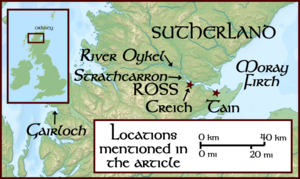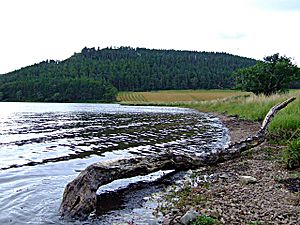Paul Mactire facts for kids
Quick facts for kids
Paul Mactire
|
|
|---|---|

Paul's name as it appears in the 15th century MS 1467.
|
|
| Spouse(s) | Mary/Mariot of Graham (niece of Hugh of Ross, Lord of Fylorth) |
| Children | Catharene (daughter) |
| Notes | |
|
Paul's wife is recorded in a charter, his daughter is known from later tradition.
|
|
Paul Mactire, also known as Paul MacTyre, was a Scottish person from the 1300s. He lived in the northern part of Scotland. We know about him from old documents and a family tree from the 1400s.
Paul married a niece of the Earl of Ross's brother. Some stories say he was a famous adventurer or 'freebooter' in northern Scotland. Local legends also say he built a fortress in Sutherland that is now in ruins. Many Scottish families believe he was their ancestor. Some sources say Paul Mactire's father was Leod Macgilleandrais.
Contents
Paul's Life in Old Records
Old records tell us about Paul Mactire. In 1365, a man named Hugh of Ross gave Paul and his wife, Mariot of Graham, some lands. Mariot was Hugh's niece. These lands were in a place called "Strathokel."
The next year, William, the Earl of Ross, gave Paul and his wife more land in Gairloch. This was for a small yearly payment. In 1372, the King of Scotland, Robert II, officially approved this gift of land.
Paul's Family Tree
Paul Mactire appears in an old book from the 1400s called MS 1467. This book shows his family history, linking him to a group called Clan Gillanders.
The MS 1467 says that Paul's great-great-grandfather was Gillanders. Gillanders was part of a family line that came from Gilleoin of the Aird. Gilleoin is also known as the ancestor of the Mackenzies and the Mathesons.
Gilleoin of the Aird lived around the year 1140. He was a powerful leader in northern Scotland. He likely took control of land in southern Ross after the Norse (Viking) power weakened in the 1000s.
Some historians believe Paul was related to Fearchar, Earl of Ross. There are different ideas about how many generations separate Paul from Gilleoin of the Aird. One idea is that a "Paul" mentioned in the manuscript might be Páll Bálkason, a sheriff from the 1200s.
The name Mactire has been discussed by experts. Some thought it meant "son of the Heir." However, a Gaelic scholar named Alexander Macbain said Tyre means "Wolf." He thought Paul might have been called "Paul the Wolf" because of stories about his actions.
Stories from the Rosses of Balnagown
An old family history of the Rosses of Balnagown tells a story about a King of Denmark. This king supposedly had three sons who came to northern Scotland. One son, "Leandres," was said to be the ancestor of "Tyre," whose son was "Paul M'Tyre."
This history says Paul M'Tyre started "Clan Lendres." His daughter, Catharene, married Walter Ross, the leader of Balnagown. The Ross family was known as 'Clan Gillanders.'
The story also says that Paul M'Tyre received yearly payments of 180 cattle from Caithness. Paul was said to have two sons, Murthow Reoche and Gillespik. Murthow Reoche was killed while collecting payments in Caithness. When Gillespik heard, he returned home to Ross.
Paul as a Clan Leader
The first five leaders of Clan Ross were also Earls of Ross. After the fifth Earl, William III, died in 1372, the leadership of the Rosses passed to the Rosses of Balnagown.
Some historians believe Paul Mactire became the chief of Clan Ross right after the fifth Earl died. They noted that the Rosses were known in Gaelic as "Clann Gille Ainnrais" (Clan Gillanders). This suggests Paul's clan in the old manuscript was the Rosses.
A document Paul received from William III called him the Earl's "cousin." This supports the idea that Paul took over leadership of the Clan Ross.
Other Tales About Paul
In the late 1700s, a traveler named Thomas Pennant wrote about a tradition in Sutherland. It said that in the 11th or 12th century, a great man named Paul Meutier lived there. He defeated an army of Danes.
The story says Paul gave his daughter in marriage to a Dane named Hulver or Leander. With her, he gave the lands of Strahohee. From this marriage, the "Clan Landris" are said to have descended.
Another writer in the 1800s, Alexander Pope, thought this "Aulver Rosta" might be the same person who married Paul Mactire's daughter. He noted that Aulver was a Dane or Norwegian, and the name Aulver is similar to Leander.
Places Connected to Paul
Around 1630, Sir Robert Gordon of Gordonstoun wrote about Paul. He said that the ruined fortress of Dun Creich was built by Paul. Paul supposedly used a very strong mortar that people couldn't identify even in the 1600s.
Gordonstoun wrote that Paul stopped building Dun Creich when he heard his only son had been killed in Caithness. This son was with an outlaw named "Murthow Raewick."
Later, in the early 1800s, John Jamieson suggested this story about Dun Creich might be a way to explain its unfinished state. He thought the strong mortar might refer to a vitrified fort, which is a type of stone fort that has been heated so much it looks like glass.
In the late 1800s, William Taylor mentioned a place near Tain called Paul MacTyre's Hill. This spot had been washed away by the sea. A scholar named William J. Watson noted a "court-hill" of Paul near Tain. He also thought "Lochan Phòil," meaning "Paul's lochlet," was named after Paul.
Paul's Descendants
Tradition says Paul was an ancestor of the Rosses of Balnagown, through his daughter's family line.
The surname Polson was found in the Creich area before 1430. Some believed this family came from Paul. However, another expert, George Fraser Black, thought Paul was wrongly assumed to be the ancestor of the Polsons.
Some of Paul's descendants are said to have taken the surname Fraser. They became leaders of Moniack. It is also said that some of these Frasers later changed their name to Barron.
See also
- Leod Macgilleandrais, said to have been the father of Paul Mactire in the late 19th, and early 20th centuries
Images for kids
-
Paul's name as it appears in the 15th century MS 1467.





